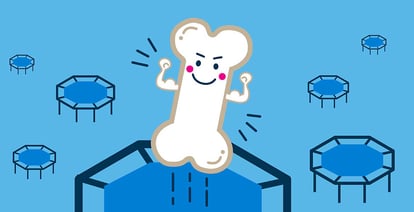Osteoporosis is a loss of bone density until they become weak and brittle. It occurs most often in astronauts, older people, and bed-ridden patients. This is because bones have the ability to become stronger under pressure but become weaker when there is no pressure on them. Gravity is a natural and effective way to put pressure on your bones, which will make them stronger.
Our bones are active, dynamic organs
People generally think of their bones as solid, static things – fixed, like the structure that holds up a house. They seem cumbersome and uninteresting, out of sight and out of mind. But this is not the case. Our bones are active, dynamic organs, which like other bodily organs are continuously producing cells, reproducing and altering themselves in order to maintain their function. And this process can go wrong.
Our bones are completely replaced every ten years. When we are young, our bones are growing and become stronger. They reach their peak strength, known as maximum bone density, at age 25-30.
After that, everything suddenly goes downhill. Bone density is lost faster than it is replaced, which is a part of the aging process.
Exercise, exercise, exercise...
Exercise can help build and maintain strong bones. Exercise that forces you to work against gravity – i.e. exercises that use your body weight, such as walking and jumping on the trampoline, is very good for bone density.
Under healthy conditions, the majority of types of exercise will strengthen your bones, but when osteoporosis occurs it is better to exercise without continuous trauma and pressure on the joints and spine, which carry the weight.
Running, jumping, floor aerobics and many other forms of recreation put the greatest loads on the joints and the spine and gradually cause pain. The important thing is to engage in types of recreation that do not have these negative consequences. Bouncing on a trampoline reduces impacts on the joints and spine by 90% and therefore allows you to enjoy safe and pleasant exercise in the comfort of your own home or gym.
Therefore it should come as no surprise that trampolines are used to rehabilitate athletes after serious injuries and operations.
Trampolines have positive effects
If you already have osteoporosis you are probably wondering whether you can exercise at all. Trampolines have positive effects on knee ligaments and the joints that they secure, protect your bones and spine against excessive pressure, and strengthen the back and hips so that they remain flexible.
Trampolining is an important part of controlling osteoporosis, but only if done regularly. You can use your trampoline every day, whenever you want.
The key to this is:
- bouncing on the trampoline at least 10 min a day,
- Just simply bouncing up and down 50 times will keep your bones strong,
- eat calcium-rich foods to keep your bones healthy.

